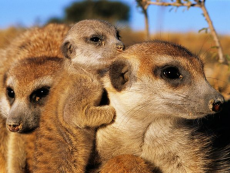
The meerkat is becoming more and more well known these days, thanks to certain adverts on television and wildlife programmes which make them appear very cute and vulnerable. However, they are far from it.
The meerkat is a member of the mongoose family, living mainly in desert areas such as Botswana and South Africa and is more than capable of defending itself. With sharp claws and teeth as weapons, meerkats are known for being extremely watchful and vigilant of their homes and family groups, also called ‘gangs’ or ‘mobs’, with them often standing guard at the entrance to their dens on the lookout for predators or other dangers. Meerkats keep watch whilst foraging for food as well, with a meerkat called a sentry standing guard and barking or whistling if it senses trouble. Surprisingly, meerkats eat rather dangerous and often venomous animals such as scorpions, snakes, spiders and even lizards, as well as other vegetation. The reason they can eat so many dangerous and poisonous animals and not become ill or die is because their bodies are immune to certain types of venom, unlike humans.
Meerkats live in what are called dens, a series of underground tunnels with many different entrances used as escape routes for a quick exit. These dens are built so far underground that it is still cool for them, even in the African desert, and can prove to be very good escape routes from predators and birds of prey. After spending the night in these cool tunnels, the meerkats have to then adjust their bodies to the heat in the world above. They do this by sunbathing as the sun rises, so as not to shock their bodies with a sudden temperature change. Only capable of short and sudden bursts of energy, meerkats must be well equipped with knowledge on finding food and foraging. They may be quick, but can only accomplish this task for a few hours in the morning and evening, after which they retreat to their tunnels and rest until it is time to begin the day all over again.

0 Comment:
Be the first one to comment on this article.